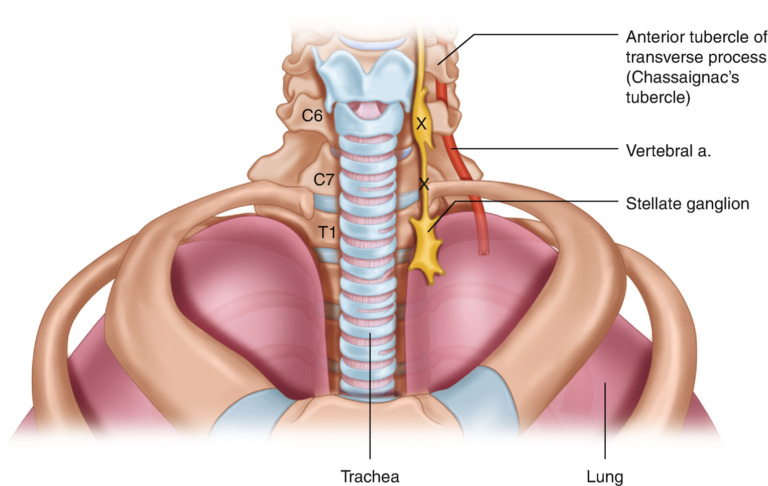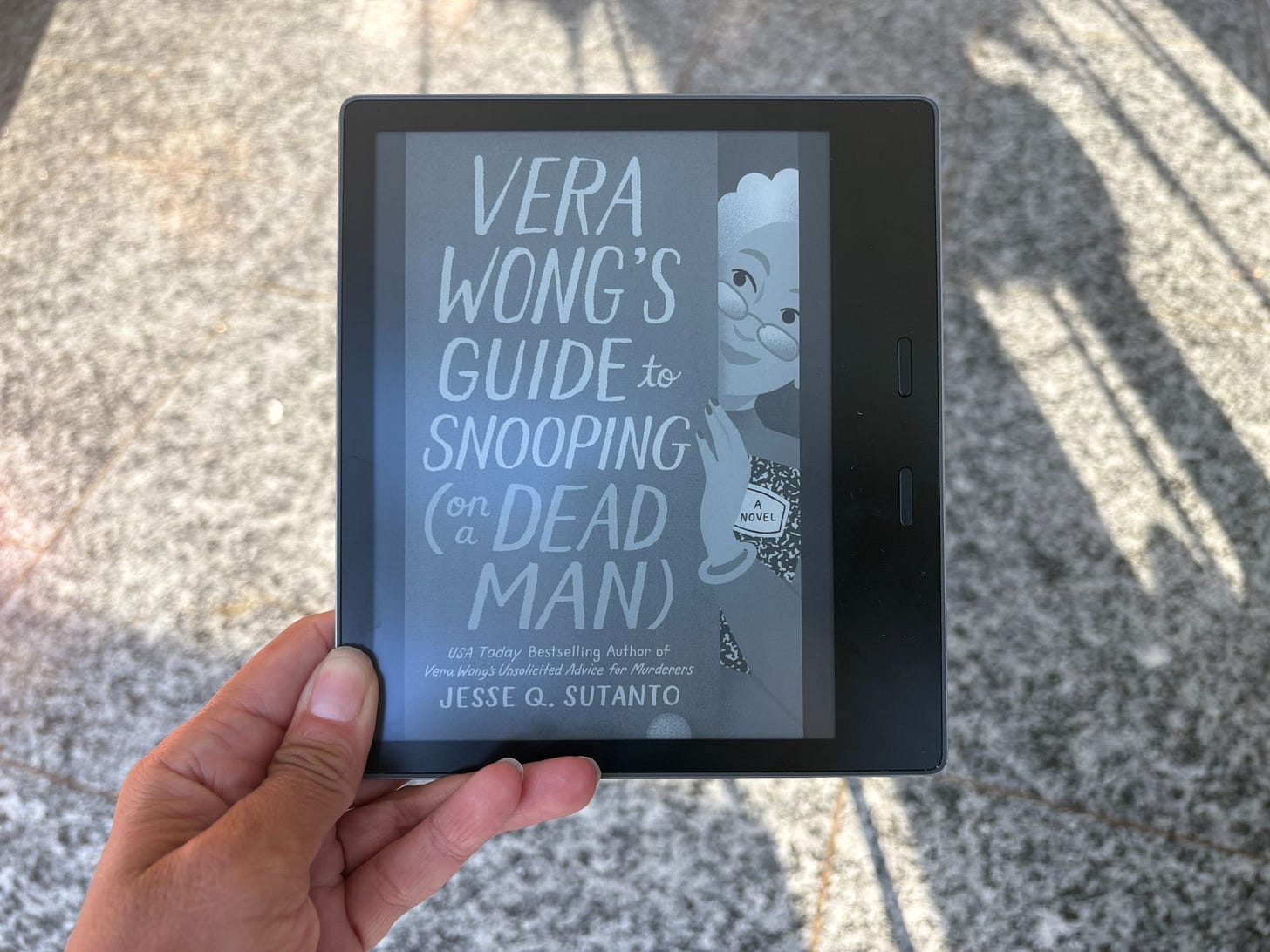#149: 💉 Using Stellate Ganglion Blocks for PTSD and Anxiety
Can Blocking Your Nerves Create a Nervous System “Reset”?
Hey friends,
I’m giving a talk titled “Can Psychedelics Slow, or Even Reverse, Aging?” in Lisbon on Tuesday, Sept 16 at 7pm at the Origem of Everywhere (R. Marcos Portugal 31, 1200-257 Lisboa).
From reversing cellular aging in mice, to easing Parkinson’s symptoms, to promoting the brain’s ability to rewire after trauma, I’ll discuss emerging research which suggests psychedelics could radically change how we understand aging.
Hope you can make it!
xo
Nina
💬 In this note:
💉 Using Stellate Ganglion Blocks for PTSD and Anxiety
📚 Vera Wong’s Guide to Snooping (on a Dead Man)
⚡️ Dolphins Getting High
💉 Using Stellate Ganglion Blocks for PTSD and Anxiety
Last week, a friend reached out asking if I'd ever heard of stellate ganglion blocks.
She'd been struggling with PTSD and generalized anxiety disorder, trying everything from traditional therapy to alternative medicine, even various medications.
Her latest therapist mentioned this procedure as something that might help "reset" her nervous system.
I'd never heard of it.
When I first googled it, I saw it could be used for pain management.
But I didn’t immediately see the application for mental health.
So I dove deeper.
The typical understanding of trauma and anxiety is that they are purely psychological.
What I found challenged this typical understanding and suggested possibilities for treating conditions we usually think of as purely psychological.
What is the Stellate Ganglion?
The stellate ganglion is a star-shaped bundle of sympathetic nerves located in your neck, near your first ribs and voice box.
In about 80% of people, it forms when two separate nerve clusters, the inferior cervical ganglion and the first thoracic ganglion, fuse together during development.
This nerve, which is a two-way conduit, connects the parts of the brain that control the fight or flight response (referred to as the central autonomic network) to the rest of the body.
What is a Stellate Ganglion Block?
It is essentially a nerve block.
A nerve block is a medical procedure where a local anesthetic is injected near a specific nerve or nerve group to stop pain signals from reaching the brain, providing temporary or long-lasting pain relief.
Therefore, in a stellate ganglion block (SGB), a doctor will inject local anesthetic into the stellate ganglion nerve cluster to temporarily "turn off" sympathetic nerve signals to your head, neck, arms, and upper chest.
For years, the Stellate Ganglion Block (SGB) has been recognized as an FDA-approved pain-relieving treatment.
Most recently, the Stellate Ganglion Block (SGB) has been used off-label to treat symptoms of PTSD, anxiety and depression because it helps regulate the brain's overactive sympathetic nervous system and "reset" the "fight-or-flight" response to its baseline.
Think of it as hitting a reset button on your nervous system's pain signals.
The Stellate Ganglion Block (SGB) for Mental Health
Researchers are studying how an SGB may help mental health conditions like PTSD, by using it to address the physical manifestation of psychological trauma.
PTSD isn't just "in your head."
It fundamentally rewires your nervous system.
In PTSD, the sympathetic nervous system becomes hyperactive, flooding the body with stress hormones like norepinephrine.
This creates the hypervigilance, sleep disruption, and an exaggerated startle response that characterize the condition.
It's like having your body's alarm system stuck in the "on" position.
Blocking the stellate ganglion with an anesthetic may then reduce nerve growth factor levels in the brain, decrease norepinephrine production and therefore “reset" the overactive sympathetic nervous system.
Since 1990, researchers have been studying this application with mixed but promising results.
In uncontrolled, unblinded, retrospective studies of a stellate ganglion block for PTSD, high rates of rapid clinical improvement in PTSD symptoms (70% to 75%) were reported.
However, when attempting to repeat these results in a randomized controlled trial (that means with blinded studies) findings neither confirmed nor refuted the previous findings.
In the randomized controlled trial, the range of PTSD improvement after one round of SGB was 5.4% to 14.7%, and was 12.1% to 21.2% after the second round, which was no better than placebo.
Can Anxiety Be Addressed With A Stellate Ganglion Block?
The theory is similar, if chronic anxiety keeps your sympathetic nervous system in overdrive, temporarily "turning it off" with an SGB might provide a reset that allows other treatments (therapy, medication, lifestyle changes) to be more effective.
In a case series of 285 patients that received a SGB, anxiety symptoms were reduced by half.
That’s an impressive result, but we have to interpret it cautiously.
The data is not from a randomized controlled trial and case series don’t have placebo groups for comparison.
Unlike PTSD, where SGB has been tested in several controlled trials, research on anxiety disorders is still sparse.
Most of the evidence comes from smaller, uncontrolled studies or from patients with overlapping PTSD and anxiety symptoms.
Still, the rationale makes sense.
Anxiety disorders share many of the same physiological features as PTSD: hyperactive amygdala circuits, elevated norepinephrine, and a nervous system tilted toward “fight or flight.”
By quieting sympathetic activity, SGB may ease some of the physical symptoms of anxiety, like a racing heart, muscle tension, and hypervigilance, that then feed the mental loop of worry.
Some patients describe the effect as an “immediate calm,” with reduced physical arousal.
Others say the block helps them engage in therapy more effectively, because their body is no longer in constant overdrive.
For people whose anxiety is primarily somatic, showing up as chest tightness, shallow breathing, or palpitations, the benefit may be very noticeable.
But an SGB is not a cure-all.
Anxiety often has multiple drivers, from genetic predisposition to learned thought patterns.
A nerve block won’t erase those, but it might interrupt the cycle long enough to allow other treatments to stick.
In other words: SGB for anxiety is promising, but still experimental.
What’s clear is that targeting the nervous system directly, rather than focusing only on the mind, opens up new ways of thinking about how we treat chronic anxiety.
Can A Stellate Ganglion Block Be Beneficial To Longevity?
The interconnectedness of our body systems, specifically our brain and body, I believe is at the core of longevity.
Stellate ganglion blocks may be able to address several key pillars of longevity (read about my 6 pillars of longevity here) - they are Sleep, Diet, Movement, Purpose, Spirituality, and Social Connection.
Sleep
It is possible that an SBG can improve sleep.
Chronic stress, anxiety and trauma keep the sympathetic nervous system in overdrive.
They all disrupt sleep architecture, and poor sleep accelerates aging.
SGBs may help restore balance to the autonomic nervous system, reducing inflammatory markers and stress hormones.
By potentially resetting an overactive nervous system, SGBs might help restore healthy sleep patterns.
Movement
When PTSD or anxiety limits physical activity due to hypervigilance or avoidance behaviors, we see rapid declines in physical health.
A nervous system reset with an SGB might enable return to movement practices.
Social Connection
Trauma and anxiety often lead to isolation, which we know is as harmful to longevity as smoking.
When people find relief from hypervigilance and anxiety, they often reconnect with relationships that support wellbeing.
A Personal Note for Those Considering This Path
After researching this topic extensively, I want to address anyone who, like my friend, is exploring stellate ganglion blocks for PTSD or anxiety.
Your struggle with these conditions is real, and the desire to find relief is completely understandable.
The chronic stress and hypervigilance of PTSD and generalized anxiety disorder don't just affect your mental state - they create physical changes in your nervous system that can impact every aspect of your health and wellbeing.
If you're considering an SGB, here are some important points to discuss with a qualified health provider:
The potential benefits:
Some people do report significant symptom relief
It may provide a "reset" that makes other treatments more effective
The procedure itself is relatively quick (less than 30 minutes)
Effects can sometimes last weeks to months
The risks:
Temporary voice changes and difficulty swallowing are common
Serious complications like collapsed lung or neurological issues are rare but possible
Results are unpredictable - some people see no benefit at all
Insurance may not cover off-label use for mental health conditions
Most importantly, stellate ganglion blocks work best as part of a comprehensive treatment approach, not as a standalone solution.
The most successful outcomes I found in the research involved combining SGB with ongoing therapy, appropriate medication management, and lifestyle interventions that support nervous system health.
So be sure to consider the full picture.
Address your sleep, exercise, nutrition, and social support alongside any medical interventions.
Lastly, only pursue SGBs with pain management specialists or anesthesiologists experienced in the procedure.
📚 Book of the Week
Vera Wong’s Guide to Snooping (on a Dead Man) by Jesse Q. Sutanto
Rating: ★★★★★
Wow. Wow. Wow.
I loved this book. I read it all in one day flying back to Lisbon.
Vera Wong’s Guide to Snooping (on a Dead Man) is the second book in Jesse Q. Sutanto’s series. This series is a cozy mystery steeped in oolong and auntie energy.
Vera Wong is hilarious. Her confidence, sass, and ability to seek out the truth while uniting people from all walks of life is admirable.
I want to be her when I grow up.
In this mystery, Vera meets a young woman outside a police station after being a victim of a phone scam. The young woman tells Vera her friend Thomas was found dead, suspected of suicide.
Suicide doesn’t make sense. And Vera’s spidey sense kicks in.
She does her auntie magic and finds anyone who knew Thomas and along the way gathers a gang of unlikely characters, revealing some who knew him as Thomas and some who knew him as an insta-famous man named Xander.
There are many twists and turns, and trust me to pick this one up to find out the ending.
You will be laughing the whole time.
I’m a big fan of Jesse Q. Sutanto, and have featured several of her books in this newsletter including:
Dial A for Aunties (Nina’s Notes BOTW #16, ★★★☆☆)
Four Aunties and a Wedding (Nina’s Notes BOTW #32, ★★★☆☆ )
Vera Wong’s Unsolicited Advice for Murderers (Nina’s Notes BOTW #60, ★★★★☆).
⚡️ Check This Out
Do dolphins use the puffer fish to get high?
Believe it or not, footage from the BBC documentary Dolphins: Spy in the Pod in Episode 2 “Pass the Puffer” (lol BBC you nailed it with that title) shows what appears to be dolphins gently chewing on and passing around pufferfish, perhaps to induce a "trance-like," narcotic effect from the fish’s neurotoxins.
More recently, Discover Wildlife (May 2025) reported dolphins playing a game of toss-and-catch with pufferfish off South Africa.
They chew them gently and seem to experience a blissed-out state from the tiny toxin doses.
The toxin, tetrodotoxin, is highly deadly in large doses but may cause mild numbing or lightheadedness in small amounts.
That said, some researchers argue the dolphins might simply be exploring their environment or engaging in curious social behavior, rather than seeking intoxication.
While it’s incredibly tempting to picture dolphins “getting high” on pufferfish, what’s actually happening remains a mix of fact, fun, and speculation making it one of nature’s most intriguing (and playful) mysteries.
P.S. New here?
Don’t miss my free guide: The 11-Minute Longevity Protocol. Download it here.
🗣️ Looking for the Nina’s Notes Podcast?
It’s available on: 🟢 Spotify, 🟣 Apple Podcasts, 🟠 Substack Podcasts
On the Nina’s Notes Podcast I interview entrepreneurs who are building products based on the science that I write about in the Nina’s Notes Newsletter.
You’ll also find voiceovers of all the weekly Nina’s Notes.
Edited by Wright Time Publishing







